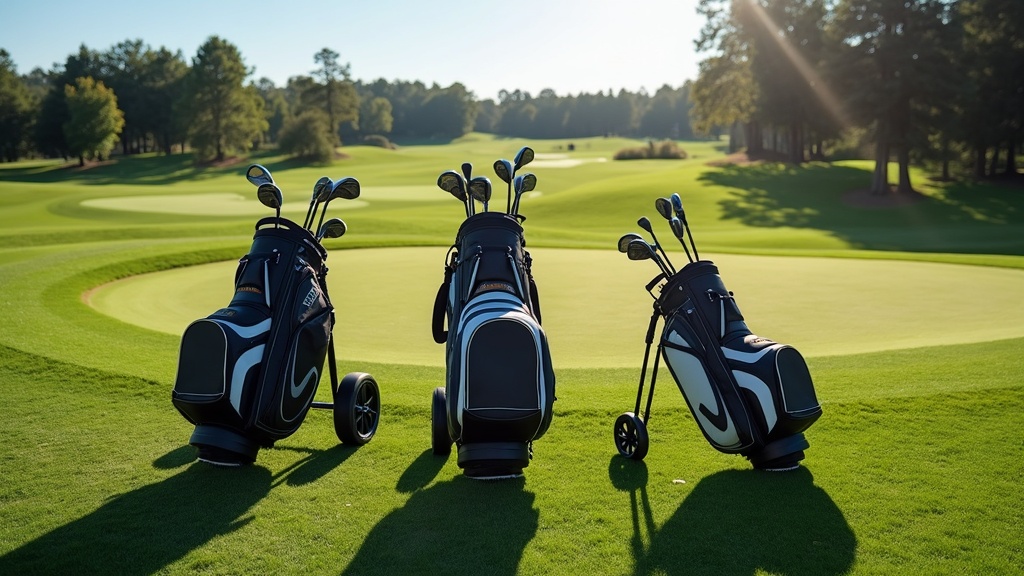If you’re into golf, you already know that having the right golf bag can make or break your round. It might seem like a small detail, but choosing the best bag for your needs actually impacts your comfort, organization, and even your performance. There are several main types out there; cart, carry, and stand bags—each with their own upsides and downsides. Here’s my straightforward guide to picking the perfect golf bag for your vibe and how you like to play.

Why Your Choice of Golf Bag Matters
The bag you bring along isn’t just about looks. It keeps your clubs safe, organizes your gear, and can even give a boost to your walking or riding experience. The market for golf bags keeps growing, with newer materials, smart storage, and lightweight frames. Golfers are spoiled for choice, so careful research helps buyers make informed decisions.
I started out with a hand-me-down cart bag that looked pretty cool, but after one particularly soggy round of carrying it myself, I realized it wasn’t the right style for me. That hands-on learning is common! Each type of golf bag is designed for a certain style of play and offers its own mix of portability, storage, and convenience. Picking the right one saves your energy and helps you focus on your game, not your sore shoulders.
The glow-up of golf bags is actually pretty interesting. Early bags were made of leather and weighed a ton compared to today’s hightech nylon or carbon fiber models. Designers now add all sorts of clever features like insulated cooler pockets, fulllength dividers, and even built-in stands. So, it pays to know what you’re getting yourself into.
Main Types of Golf Bags: Cart, Carry, and Stand
Each type of golf bag suits a different type of golfer and course experience. Here’s a breakdown on how they compare, what makes each kind useful, and who they usually fit best.
- Cart Bags: Made for golfers who mostly ride in a cart. They offer tons of space, are very sturdy, and fit perfectly on power or push carts.
- Carry Bags (Sunday Bags): The lightest and simplest, with just enough space for clubs and a few essentials. These are great for minimalists, walking short courses, or quick ninehole rounds.
- Stand Bags: Known for their involved leg mechanism that pops out, letting the bag stand on its own. These are a go-to for most walkers who want a balance of comfort, storage, and convenience.
Your preferred way to play golf usually determines which bag makes the most sense. Some folks even keep two different styles at home for flexibility, especially if they bounce between walking and riding rounds.
Pros and Cons of Each Golf Bag Type
No golf bag is perfect for every golfer. It’s helpful to size up the perks and possible downsides:
- Cart Bags: Tons of pockets, large and stable, but can get heavy and awkward if you need to carry them any distance.
- Carry Bags: Super lightweight and effortless to move around, but usually offer only basic storage and little protection in rough weather.
- Stand Bags: Good compromise between size and storage. Can be a bit heavier than carry bags, but the stand feature is really helpful when hitting shots or on practice ranges.
Deciding Factors: Which Bag Is Right for You?
The trick to choosing your ideal golf bag is honestly looking at your own habits and needs. Here are some questions:
- How do you usually play? If you take a cart every time, a cart bag makes sense. If you walk the course, stand or carry bags are designed for that.
- How much do you bring? If rain gear, snacks, rangefinders, and extra balls fill your pockets, you’ll want a bag with more storage.
- How far do you carry your bag in a typical round? Minimal weight can save your back and shoulders when you walk 18 holes or practice for hours.
- What’s the weather like where you play? Waterproofing and sturdy materials matter more in rainy or unpredictable climates.
The right bag fits how you play, not just how it looks. When I finally switched to a lightweight stand bag, I noticed my energy on the back nine was way better than before, making golf much more enjoyable. That boost encouraged me to walk instead of ride a cart, and I started appreciating the course in a whole new way.
Some golfers also consider the courses they play most often. If your local track is hilly or has longer distances between tees, the weight and strap system matter even more. If your favorite range offers cart rentals at a great rate, then a heavier, more storage-friendly cart bag might appeal to you.
Key Features to Look For in a Golf Bag
There’s more to a golf bag than just carrying clubs. Here’s what I keep an eye out for, regardless of which type I pick:
- Weight: Lighter bags mean less strain. Even cart bags made with modern materials can be surprisingly easy to handle.
- Dividers: Fulllength dividers help prevent club clatter and make it easier to pull clubs in and out.
- Pockets: Look for options like insulated cooler pockets, dedicated valuables pouches, and easyaccess ball or tee holders.
- Strap System: Dual straps make stand and carry bags comfortable. Padded, adjustable systems help a lot on long walks.
- Durability: Reinforced bottoms, heavyduty zippers, and weatherresistant fabrics help your bag last.
Testing out different options in a golf shop can be pretty handy. Try slinging a few over your shoulder, and you’ll quickly notice how ergonomic designs can make a world of difference.
Don’t forget color and style preferences, too. Bag brands now offer everything from bright, eye-catching patterns to classic, subtle designs. Going for something that reflects your personality can make you enjoy your gear even more.
Extra Tips for Choosing and Using Your Golf Bag
I’ve picked up a few hacks and details to make golf bag shopping (and use) less of a guessing game:
- If you walk the course regularly, prioritize weight first, then storage.
- If you use a push cart, make sure the bottom of the bag is a good fit for your cart’s base. Odd mismatches can lead to annoyance fast.
- Waterproof zippers and seams sealed pockets might sound overkill, but they’re really important if you play through rain or early morning dew.
- Test the stand legs in person if you’re choosing a stand bag. Flimsy legs can fail at the worst times, especially on wet or sloped grass.
- Every so often, empty your whole bag and repack it. You’ll be surprised by how much junk collects inside after a few rounds.
- Some bags have extra features like towel rings, umbrella sleeves, and marker holders. Decide if you use them enough to make a difference on your rounds.
- If you value security, look for lockable pouches or hidden pockets for car keys and wallets.
Periodic cleaning is worth the effort, especially if you play in muddy or sandy areas. You can brush out dirt, check zippers, and keep all pockets fresh.
Real-World Use Cases: When to Pick Which Bag
- Cart Bag: For golfers who book a cart every time, play at a club with caddies, or want lots of extra gear, a cart bag is the obvious pick.
- Stand Bag: If you split time between riding and walking, or go to the practice range often, a stand bag provides the most flexibility. These bags are the Swiss Army Knife of golf accessories.
- Carry Bag: Perfect for par3 courses, beginners, or anyone who likes to sneak in a quick round without using a whole set of clubs.
I keep a lightweight carry bag in my trunk for travel and casual rounds, plus a stand bag for full 18hole days. Some friends stick to one style, but there’s no rule saying you can’t mix it up or adapt as your playing style changes over time.
Frequently Asked Questions
Choosing a golf bag raises a few common questions. Here’s some straight-talk answers:
Question: Can I use a stand bag on a golf cart?
Answer: Totally. Most stand bags fit on carts just fine; just make sure to secure the legs and straps so nothing flops around.
Question: Are expensive golf bags worth it?
Answer: Not always. A durable, comfortable mid-price bag often offers more practical value than going top shelf, unless you really want certain features or luxury style.
Question: How long will a good golf bag last?
Answer: With regular care and cleaning, even a well used bag can last five years or more. Watch out for broken zippers and worn straps; that’s often when it’s time for a replacement.
Question: Should I get a waterproof golf bag if I rarely play in the rain?
Answer: If rain isn’t a factor for you, it might not be worth the extra cost—but unexpected wet days can happen, so at least check for water-resistant fabrics or rain covers as bonus features.
Getting the Most Out of Your Golf Bag
The perfect golf bag is about protecting your gear, making it easy to organize your stuff, and keeping you comfortable on the course. Whether you prefer the roomy build of a cart bag, the nimble feel of a carry bag, or the versatility of a stand bag, finding your match makes the game feel smoother. I recommend checking out bag reviews, trying options in-store, and thinking honestly about your routines before making your pick. Once you’ve got the right bag, you’ll probably wonder why you waited so long to upgrade; your shoulders and back will thank you!
Wrapping up, the right golf bag is more than storage—it’s part of what makes your round enjoyable, organized, and stress-free. Track down the features that mean the most to you, give a few bags a hands-on test whenever possible, and you’ll soon find yourself wishing you’d made the switch sooner. Happy golfing!
